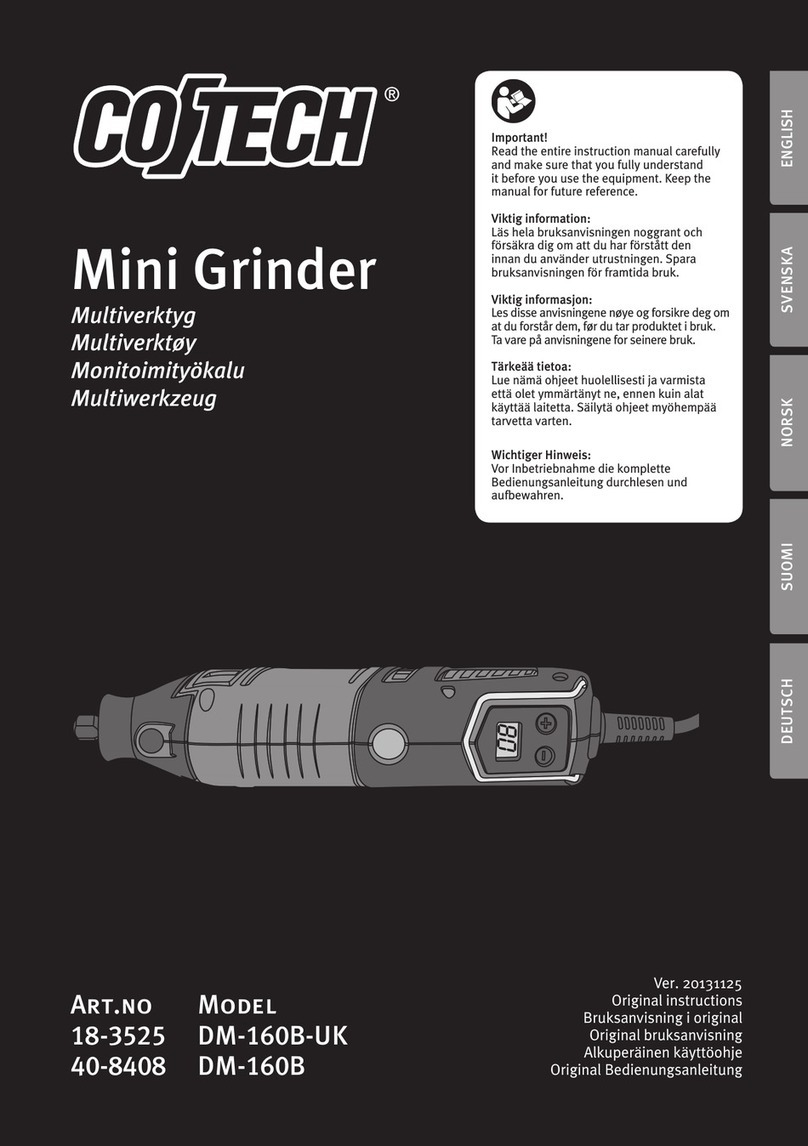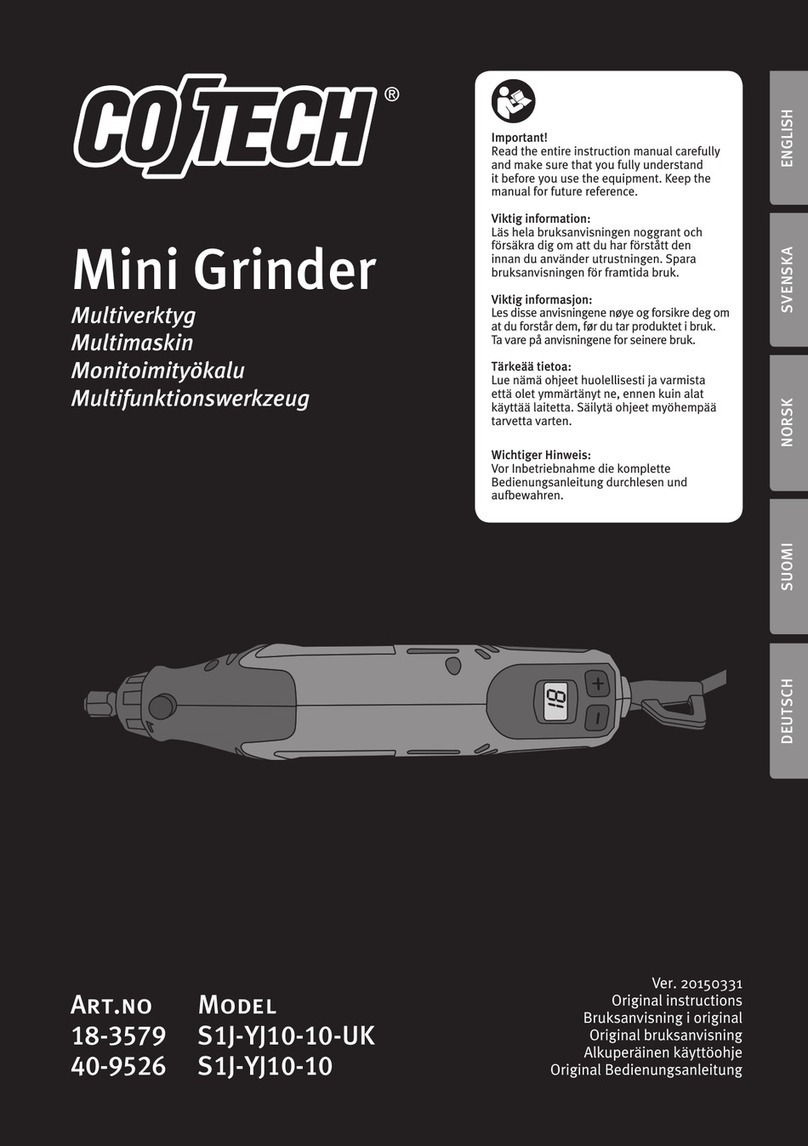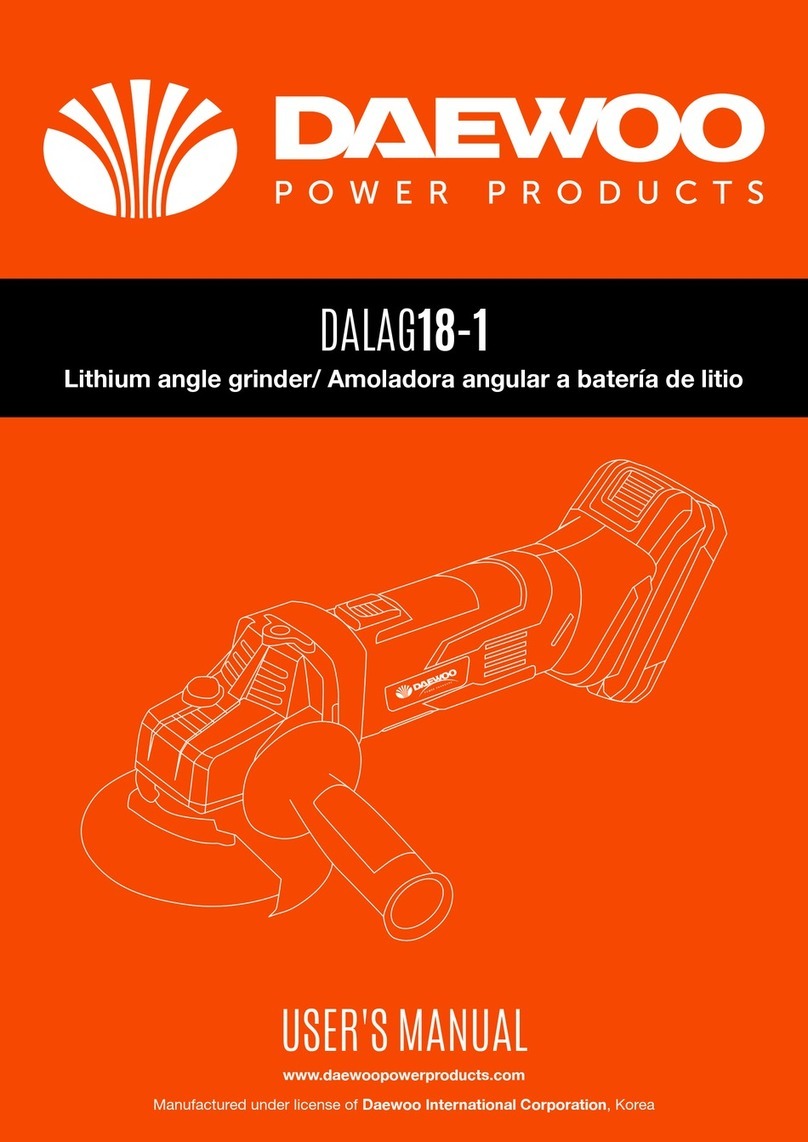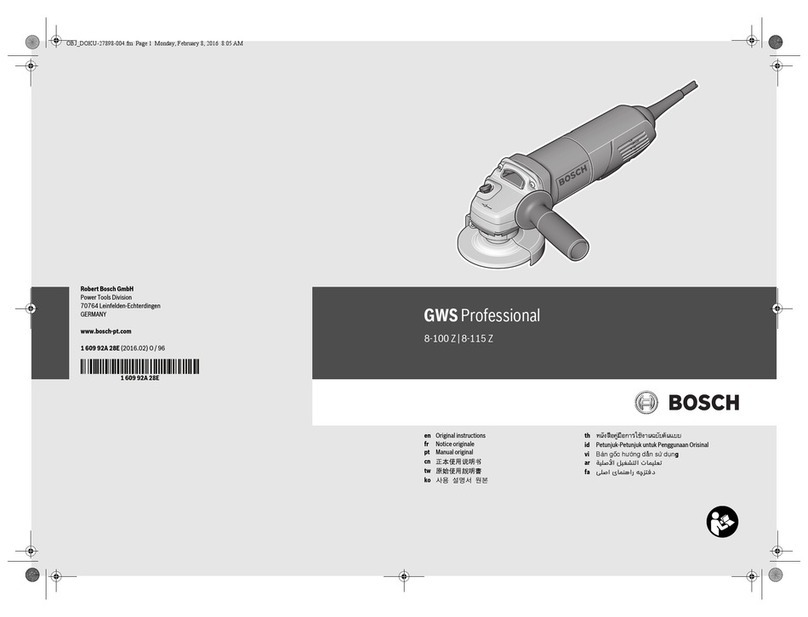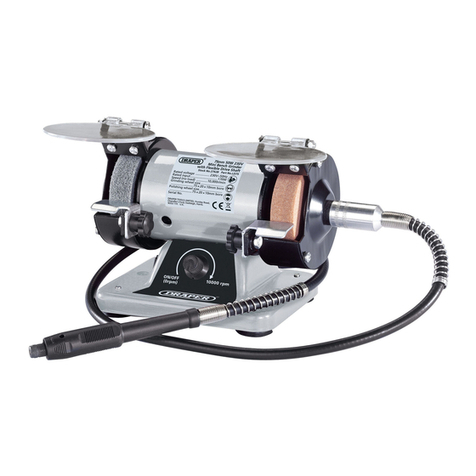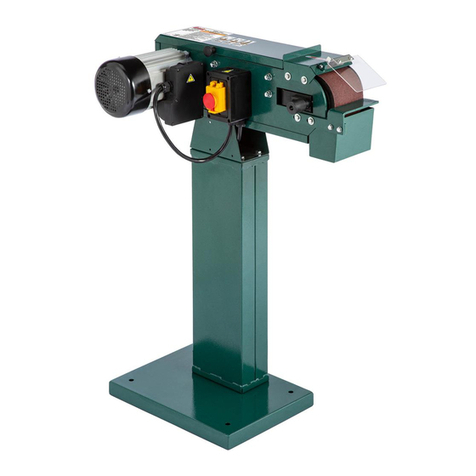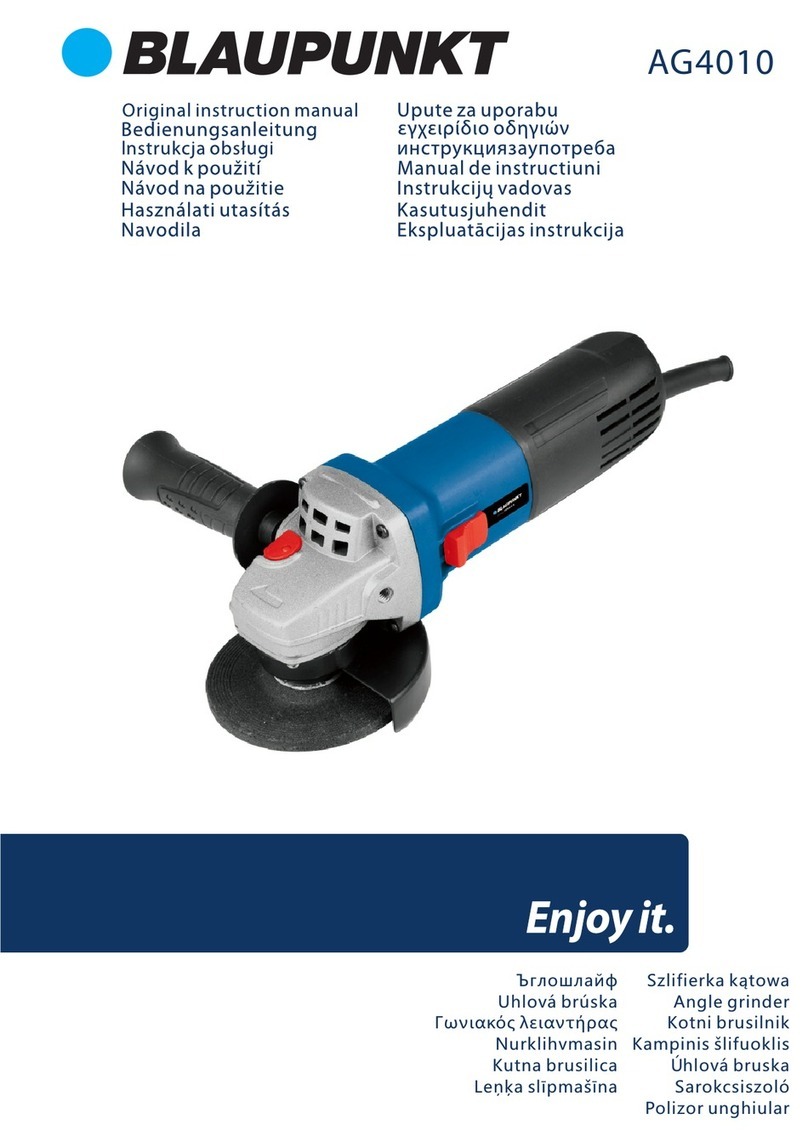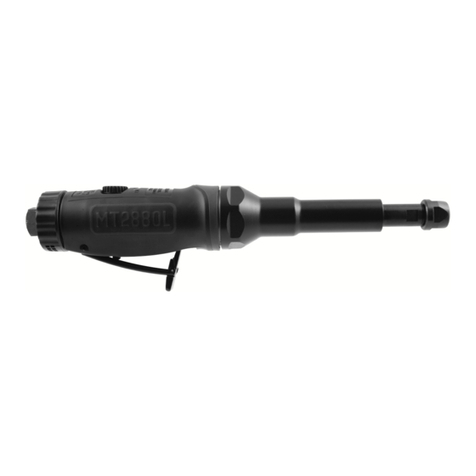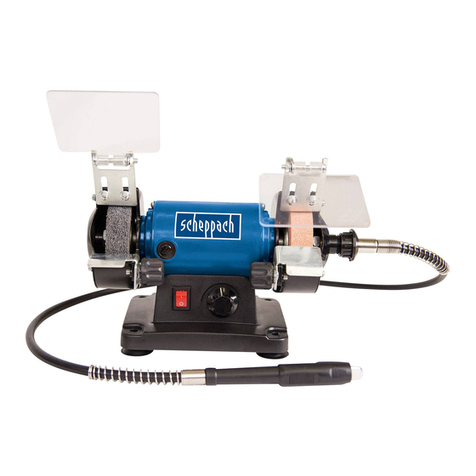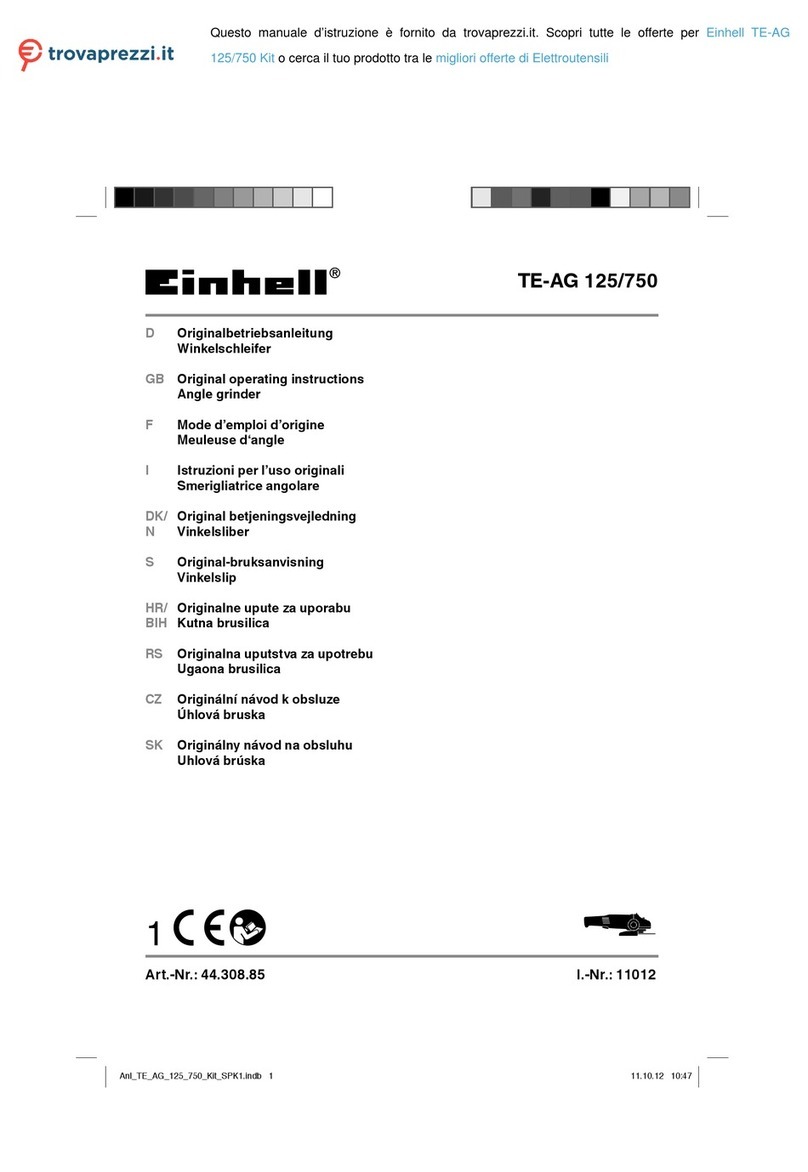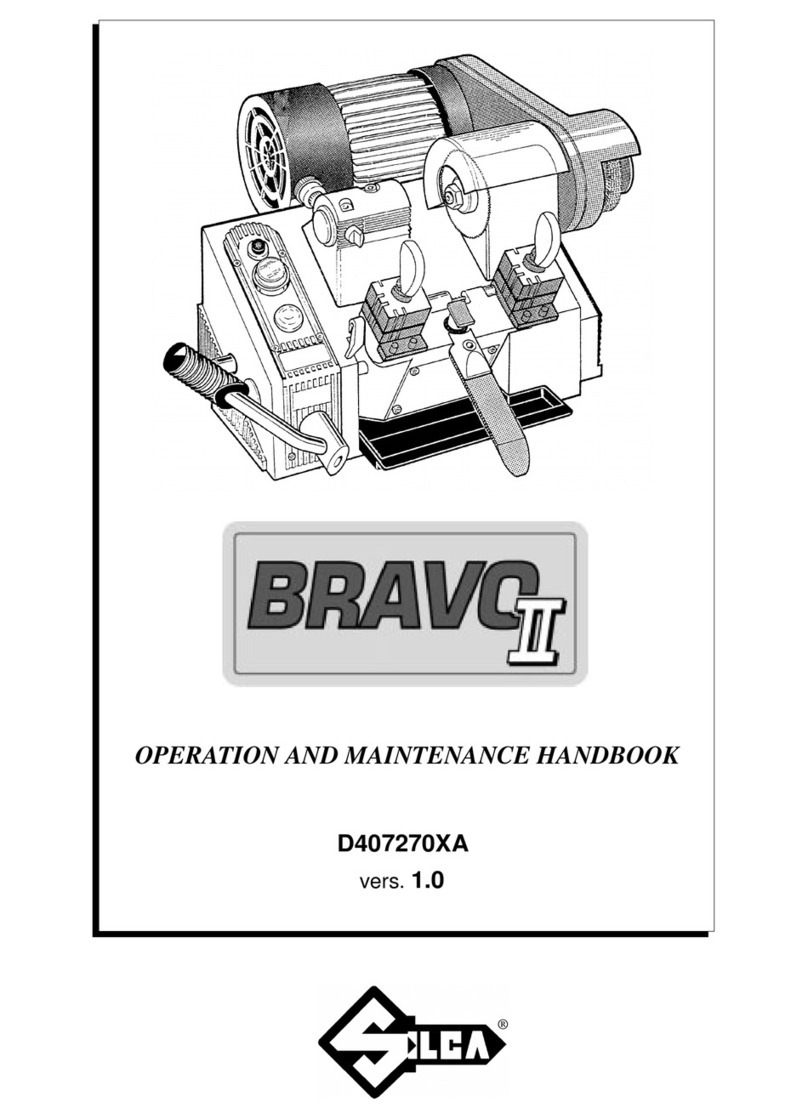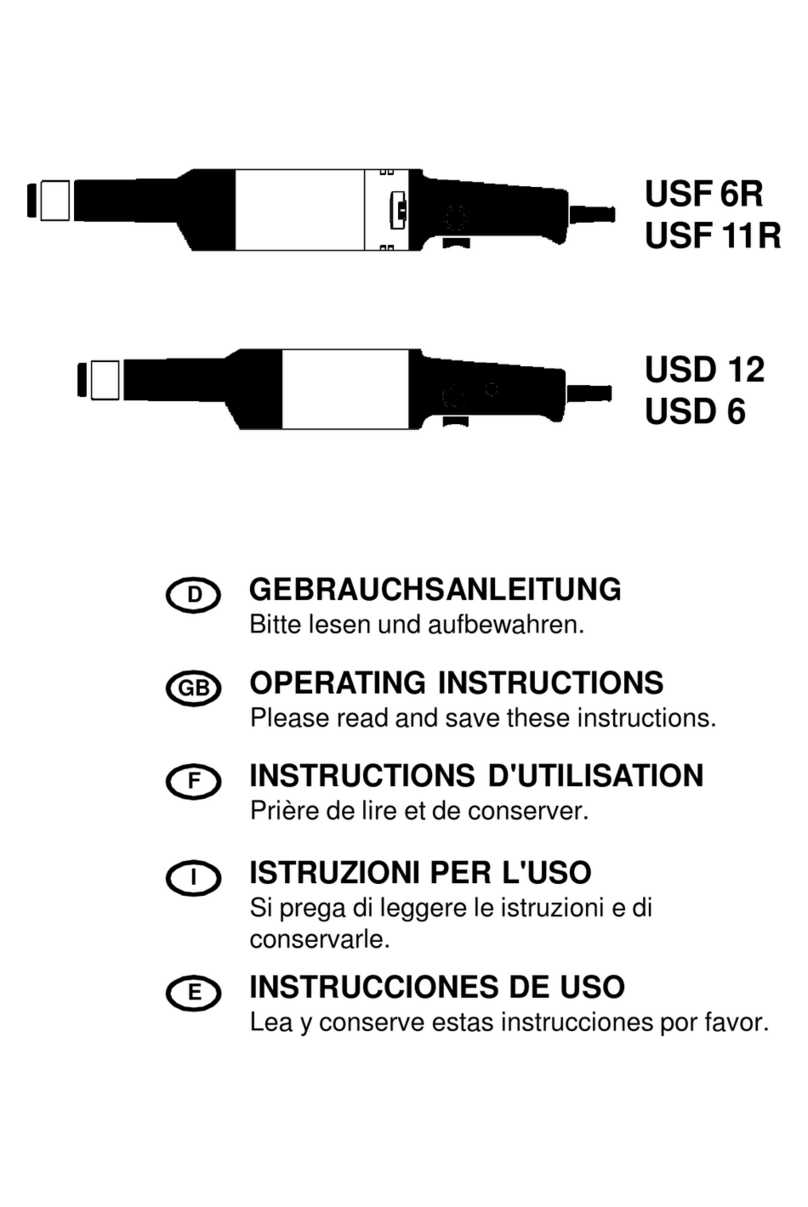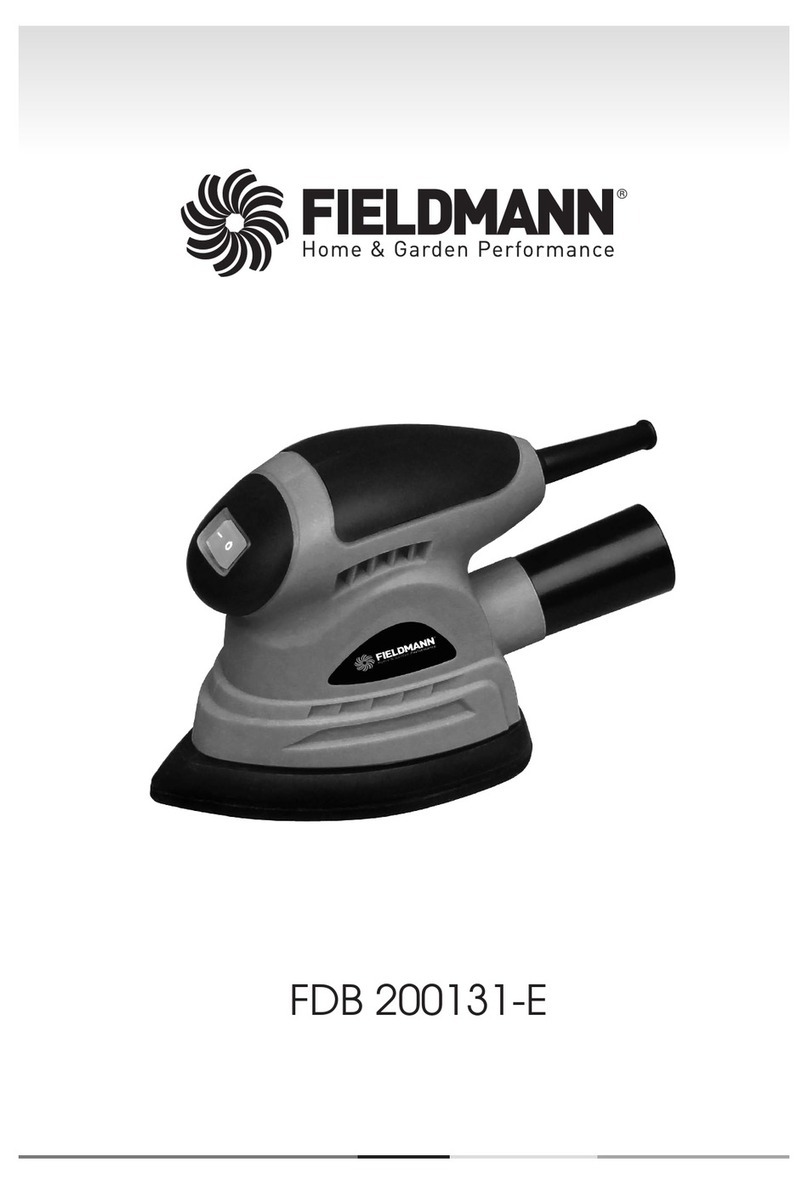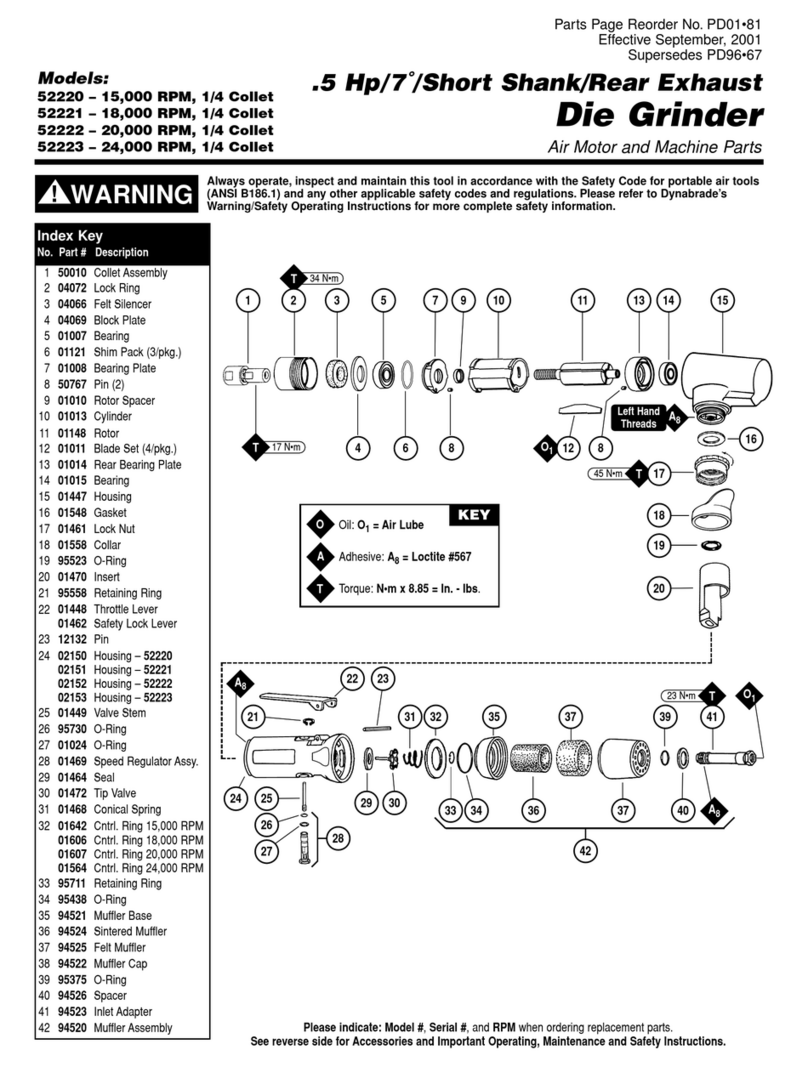CO/Tech CT3234 User manual

Vinkelslipmaskin
Vinkelslipemaskin
Kulmahiomakone
Ver. 001-200604
Important!
Read the entire instruction manual carefully
and make sure that you fully understand
it before you use the equipment. Keep the
manual for future reference.
Viktig information:
Läs hela bruksanvisningen noggrant och
försäkra dig om att du har förstått den innan
du använder utrustningen och spara den för
framtida bruk.
Viktig informasjon:
Les disse anvisningene nøye og forsikre deg
om at du forstår dem før du bruker enheten
og oppbevar dem for senere bruk.
Tärkeätä tietoa:
Lue nämä ohjeet huolellisesti ja varmista
että olet ymmärtänyt ne, ennen kuin alat
käyttää laitetta. Säilytä ohjeet myöhempää
tarvetta varten.
Art.no Model
30-9316 CT3234
ENGLISHSVENSKANORSKSUOMI
Angle Grinder
Ver. 200802

2

3
ENGLISH
Angle Grinder
Art. no. 30-9316, model CT3234
Please read the entire instruction manual before using the product and save it for
future reference. We apologise for any text or photographic errors and any changes
of technical data. If you have any questions concerning technical problems please
contact our Customer Service Department (see address on reverse.)
Table of Contents
Safety 4
Product Description 11
Assembly 12
Use 13
Changing of grinding wheel 14
Rotating the rear handle 14
Care and Maintenance 15
Troubleshooting Guide 15
Disposal 15
Specications 15

4
ENGLISH
1. General safety instructions
Warning! Read all the instructions. Failure to adhere to the following instructions
may lead to electric shocks, res and/or serious injury. The term “electrical hand
tools” in the warning text below is referring to your mains operated or battery
operated hand tool.
1) The work space
a) Keep the work space clean and well illuminated. Cluttered and poorly lit areas
invite accidents.
b) Do not use electrical hand tools in explosive environments, i.e. nearby
ammable liquids, gas or dust. Electrical hand tools generate sparks that could
easily ignite dust or fumes.
c) Keep away from children and other spectators while using the electrical hand
tool. Distractions can make you lose your concentration and control.
2) Electrical safety
a) The electrical hand tool’s plug must t correctly in the wall socket. Never modify
the plug in any way. Never use an adaptor together with earthed electrical hand
tools. Unmodied plugs and suitable wall sockets decrease the risk of electric
shock.
b) Avoid body contact with earthed objects, such as pipes, radiators, ovens or
refrigerators. There is an increased risk of electrical shock if your body is
earthed.
c) Do not expose the electrical hand tool to rain or other wet conditions. If water
gets inside an electrical hand tool it increases the risk of electrical shock.
d) Do not misuse the lead. Never use the lead to carry, drag or pull the plug out of
the wall socket. Keep the lead away from heat, oil, sharp edges and movable
parts. Damaged or tangled leads increase the risk of electrical shock.
e) When you use an electrical hand tool outdoors; use an extension cord suitable
for this purpose. Use of an extension cord for outdoor use decreases the risk of
electrical shock.
3) Personal safety
a) Pay attention to what you do and use common sense when using electrical hand
tools. Never use an electrical hand tool if you are tired or under the inuence
of drugs, alcohol or medication. One moment of inattention while using an
electrical hand tool may result in serious injury.
b) Use protective equipment. Always use safety glasses. Using protective
equipment such as a face mask, slip resistant protection shoes, a helmet and
ear plugs when needed decreases the risk of injury.

5
ENGLISH
c) Avoid unexpected starts. Make sure that the switch is set to OFF before you
connect the device to the wall socket. Never carry an electrical hand tool with
one nger on the trigger or never connect the hand tool to a wall socket when
the switch is set to ON, since it may result in injury.
d) Remove all service tools/keys before switching on the hand tool. A forgotten
service tool on a rotating part of the electrical hand tool may result in injury.
e) Do not overreach. Make sure you stand steady and well balanced at all times.
This gives better control in unexpected situations.
f) Wear suitable clothing. Do not wear loose tting clothes or jewellery. Keep hair,
clothes and gloves away from movable parts. Loose tting clothes, jewellery or
long hair could get caught in movable parts.
g) If the equipment for suctioning or dust collecting is available make sure it is
connected and used properly. Using technical aids may reduce dust related
hazards.
4) Use and maintenance of the electrical hand tools
a) Do not overdrive the hand tool. Use a hand tool suitable for the work you are to
perform. At the correct rate of feed, the correct tool will carry out the work better
and more safely.
b) Never use the electrical hand tool if the switch does not work properly to turn
on and shut off the tool. All electrical hand tools that cannot be operated by the
switch are dangerous and must be repaired.
c) Unplug the lead from the wall socket before making any adjustments, changes
of accessories or storing the electrical hand tool away. These precautions
reduce the risk of unexpected starts of the electrical hand tool.
d) Store electrical hand tools that are not being used out of reach from children.
Do not let people unfamiliar with the electrical hand tool or its instructions
use it. Electrical hand tools can be dangerous if they get into the hands of
inexperienced users.
e) Maintenance of electrical hand tools. Check if something is incorrectly set, if
movable parts are getting jammed, or parts are broken or something else that
might cause the electrical hand tool to malfunction. If something is damaged it
must be repaired before use. Many accidents are caused by poorly maintained
electrical hand tools.
f) Keep the tools sharp and clean. Properly maintained cutting tools with sharp
blades are less likely to jam and are easier to control.
g) Use the electrical hand tool, accessories and such according to the instructions
and in a way suitable for the type of electrical hand tool used. Using the
electrical hand tool for work other than that for which it is intended could result in
a dangerous situation.

6
ENGLISH
5) Service
a) Let only qualied personel perform service and repairs using original parts.
This guarantees that the safety of the electrical hand tool is maintained.
5) Service
a) Låt behörig personal utföra service och reparationer, och endast med
originalreservdelar. Detta garanterar att säkerheten på det elektriska
handverktyget behålls.
2. Safety warnings common for grinding,
sanding, wire brushing, polishing or abrasive
cutting-off operations
a) This power tool is intended to function as a grinder, sander, wire brush or cut-
off tool. Read all safety warnings, instructions, illustrations and specications
provided with this power tool. Failure to follow all instructions listed below may
result in electric shock, re and/or serious injury.
b) Operations such as polishing are not recommended to be performed with this
power tool. Operations for which the power tool was not designed may create a
hazard and cause personal injury.
c) Do not use accessories which are not specically designed and recommended
by the tool manufacturer. Just because the accessory can be attached to your
power tool, it does not assure safe operation.
d) The rated speed of the accessory must be at least equal to the maximum speed
marked on the power tool. Accessories running faster than their rated speed can
break and y apart.
e) The outside diameter and the thickness of your accessory must be within the
capacity rating of your power tool. Incorrectly sized accessories cannot be
adequately guarded or controlled.
f) The arbour size of wheels, anges, backing pads or any other accessory must
properly t the spindle of the power tool. Accessories with arbour holes that
do not match the mounting hardware of the power tool will run out of balance,
vibrate excessively and may cause loss of control.
g) Do not use a damaged accessory. Before each use inspect the accessory
such as abrasive wheels for chips and cracks, backing pad for cracks, tear or
excess wear, wire brush for loose or cracked wires. If power tool or accessory
is dropped, inspect for damage or install an undamaged accessory. After
inspecting and installing an accessory, position yourself and bystanders away
from the plane of the rotating accessory and run the power tool at maximum
no-load speed for one minute. Damaged accessories will normally break apart
during this test time.

7
ENGLISH
h) Wear personal protective equipment. Depending on application, use face shield,
safety goggles or safety glasses. As appropriate, wear dust mask, hearing
protectors, gloves and workshop apron capable of stopping small abrasive or
workpiece fragments. The eye protection must be capable of stopping ying
debris generated by various operations . The dust mask or respirator must be
capable of ltrating particles generated by your operation. Prolonged exposure
to high intensity noise may cause hearing loss.
i) Keep bystanders a safe distance away from work area. Anyone entering the
work area must wear personal protective equipment. Fragments of workpiece or
of a broken accessory may y away and cause injury beyond immediate area of
operation.
j) Hold power tool by insulated gripping surfaces only, when performing an
operation where the cutting accessory may contact hidden wiring or its own
cord. Cutting accessory contacting a “live” wire may make exposed metal parts
of the power tool “live” and shock the operator.
k) Position the cord clear of the spinning accessory. If you lose control, the cord
may be cut or snagged and your hand or arm may be pulled into the spinning
accessory.
l) Never lay the power tool down until the accessory has come to a complete stop.
The spinning accessory may grab the surface and pull the power tool out of your
control.
m) Do not run the power tool while carrying it at your side. Accidental contact with
the spinning accessory could snag your clothing, pulling the accessory into your
body.
n) Regularly clean the power tool’s air vents. The motor’s fan will draw the dust
inside the housing and excessive accumulation of powdered metal may cause
electrical hazards.
o) Do not operate the power tool near ammable materials. Sparks could ignite
these materials.
p) Do not use accessories that require liquid coolants. Using water or other liquid
coolants may result in electrocution or shock.

8
ENGLISH
Kickback and Related Warnings
Kickback is a sudden reaction to a pinched or snagged rotating wheel, backing pad,
brush or any other accessory. Pinching or snagging causes rapid stalling of the
rotating accessory which in turn causes the uncontrolled power tool to be forced in
the direction opposite of the accessory’s rotation at the point of the binding.
For example, if an abrasive wheel is snagged or pinched by the workpiece, the
edge of the wheel that is entering into the pinch point can dig into the surface of
the material causing the wheel to climb out or kick out. The wheel may either jump
toward or away from the operator, depending on direction of the wheel’s movement
at the point of pinching. Abrasive wheels may also break under these conditions.
Kickback is the result of power tool misuse and/or incorrect operating pro-
cedures or conditions and can be avoided by taking proper precautions as
given below.
a) Maintain a rm grip on the power tool and position your body and arm to allow
you to resist kickback forces. Always use auxiliary handle, if provided, for
maximum control over kickback or torque reaction during start-up. The operator
can control torque reactions or kickback forces, if proper precautions are taken.
b) Never place your hand near the rotating accessory. Accessory may kickback
over your hand.
c) Do not position your body in the area where power tool will move if kickback
occurs. Kickback will propel the tool in direction opposite to the wheel’s
movement at the point of snagging.
d) Use special care when working corners, sharp edges etc. Avoid bouncing and
snagging the accessory. Corners, sharp edges or bouncing have a tendency to
snag the rotating accessory and cause loss of control or kickback.
e) Do not attach a saw chain woodcarving blade or toothed saw blade. Such
blades create frequent kickback and loss of control.
Safety Warnings specific for grinding and abrasive cutting-off
operations
a) Use only wheel types that are recommended for your power tool and the specic
guard designed for the selected wheel. Wheels for which the power tool was not
designed cannot be adequately guarded and are unsafe.
b) The guard must be securely attached to the power tool and positioned for
maximum safety, so the least amount of wheel is exposed towards the operator.
The guard helps to protect operator from broken wheel fragments and accidental
contact with wheel.

9
ENGLISH
c) Wheels must be used only for recommended applications. For example: do
not grind with the side of cut-off wheel. Abrasive cut-off wheels are intended
for peripheral grinding, side forces applied to these wheels may cause them to
shatter.
d) Always use undamaged wheel anges that are of correct size and shape for
your selected wheel. Proper wheel anges support the wheel thus reducing the
possibility of wheel breakage. Flanges for cut-off wheels may be different from
grinding wheel anges.
e) Do not use worn down wheels from larger power tools. Wheels intended for
larger power tool are not suitable for the higher speed of a smaller tools and
may burst.
Additional Safety Warnings specific for abrasive cutting-off
operations
a) Do not “jam” the cut-off wheel or apply excessive pressure. Do not attempt to
make an excessive depth of cut. Overstressing the wheel increases the loading
and susceptibility to twisting or binding of the wheel in the cut and the possibility
of kickback or wheel breakage.
b) Do not position your body in line with and behind the rotating wheel. When the
wheel, at the point of operation, is moving away from your body, the possible
kickback may propel the spinning wheel and the power tool directly at you.
c) When wheel is binding or when interrupting a cut for any reason, switch off
the power tool and hold the power tool motionless until the wheel comes to a
complete stop. Never attempt to remove the cut-off wheel from the cut while
the wheel is in motion otherwise kickback may occur. Investigate and take
corrective action to eliminate the cause of wheel binding.
d) Do not restart the cutting operation in the workpiece. Let the wheel reach full
speed and carefully re-enter the cut. The wheel may bind, walk up or kickback if
the power tool is restarted in the workpiece.
e) Support panels or any oversized workpiece to minimize the risk of wheel
pinching and kickback. Large workpieces tend to sag under their own weight.
Supports must be placed under the workpiece near the line of cut and near the
edge of the workpiece on both sides of the wheel.
f) Use extra caution when making a “pocket cut” into existing walls or other blind
areas. The protruding wheel may cut gas or water pipes, electrical wiring or
objects that can cause kickback.

10
ENGLISH
Read the safety and operating instructions
Always use ear defenders. Always use safety glasses or a visor
and wear a face mask.
Safety Warnings specific for sanding operations
a) Do not use excessively oversized sanding disc paper. Follow manufacturers
recommendations, when selecting sanding paper. Larger sanding paper
extending beyond the sanding pad presents a laceration hazard and may cause
snagging, tearing of the disc or kickback.
Safety Warnings specific for wire brushing operations
a) Be aware that wire bristles are thrown by the brush even during ordinary
operation. Do not overstress the wires by applying excessive load to the brush.
The wire bristles can easily penetrate light clothing and/or skin.
b) If the use of a guard is recommended for wire brushing, do not allow any
interference of the wire wheel or brush with the guard. Wire wheel or brush may
expand in diameter due to work load and centrifugal forces.
Product marking with safety symbols

11
ENGLISH
3. Product Description
a) Handle
b) Shatter guard
c) Inner ange
d) Grinding wheel (not included)
e) Outer ange
f) Spanner
g) Power Switch
h) Machine body
i) Locking button for rotation of handle
B
C
D
E
F
A
G
H
I

12
ENGLISH
4. Assembly
1. Screw the side handle on the side of the gearbox that ts best. Insert the rubber
plugs in the holes that are not used. Three different kinds of assembly are
possible.
2. Place the inner unthreaded ange (C) on the spindle and twist it until it locks on
the spindle.
3. Put on a grinding/cutting disc (D) on the spindle so it centres.
4. Put on the outer ange (E) with the concave side towards the disc.
5. Push in the spindle lock and tighten the ange clockwise with the included key.
6. Start the machine and let it run for awhile to make sure the disc is balanced
before grinding.
B
C
D
E
F

13
ENGLISH
5. Use
• Let the machine come up to speed before grinding.
• Make sure you have good overview when grinding.
• Do not use the side of cutting discs for grinding since they cannot handle
pressure to the face.
• Use a diamond grinding wheel when cutting stone etc.
• Do not angle the machine while cutting. Make straight cuts only with
a cutting disc.
1. Stand steady and hold the machine rmly in both hands.
2. Push the switch forward and then up.
3. Turn off the machine by releasing the switch.
4. The best method for grinding is to hold the machine in at a 10-15º angle.

14
ENGLISH
Spindle Lock Button
6. Changing of grinding wheel
The grinding wheel must have the correct inner diameter. Never use loose sleeves.
It should be approved for at least 8500 rpm.
1. Pull out the plug from the outlet before changing the grinding disc.
2. Activate the spindle loc. Loosen the spindle bolt from the outer ange of the
spindle.
3. Remove the old grinding disc and attach a new one.
4. Assemble in reversed order.
5. Start the machine and let it run for awhile to make sure the disc is balanced
before grinding.
7. Rotating the rear handle
1. Unplug the mains lead before rotating the handle.
2. Push in the locking button to rotate the handle.
3. Rotate the handle to one of the three set positions.
4. Release the locking button and make sure the handle clicks in position.
Locking buttton

15
ENGLISH
8. Care and Maintenance
Always keep the motor’s ventilation openings free of dust and debris. If needed
dry off the angle grinder with a soft damp cloth. Avoid strong detergents or sol-
vents.
9. Troubleshooting Guide
Problem Possible Cause Remedy
The machine does
not start.
No power. Check the power point.
Worn brushes. Contact Customer Service in
case of motor or electrical faults.
Short circuit.
Faulty power switch.
The machine runs
slowly.
Worn/damaged cutter/bit. Sharpen or change the cutter/bit.
Speed too low. Do not press down too hard.
The motor is overheated.
Strange noise. Mechanical fault. Contact us in case of motor or
electrical faults.
Faulty windings.
Strong vibrations. Loose cutter/bit. Tighten the tool and make sure
it is set correctly.
Sparks in the
motor.
Brushes jammed. Contact Customer Service in
case of motor or electrical faults.
Winding short circuited.
Dirt on collector.
10. Disposal
Follow local ordinances when disposing this product. If you are unsure
about the disposal of this product contact your municipality.
11. Specifications
Power Supply 230 V ~ 50 Hz
Power 1800 W
No-Load Speed: 8500 rpm
Grinding Wheel Ø 180 mm, hole Ø 22 mm
Weight 4.7 kg (excluding grinding wheel)
Sound Pressure (LpA) 95 dB (A)
Sound Power (Lwa) 108 dB (A)
Vibration Value 4.7 m/s²

16
SVENSKA
Vinkelslipmaskin
art.nr 30-9316, modell CT3234
Läs igenom hela bruksanvisningen före användning och spara den sedan för
framtida bruk. Vi reserverar oss för ev. text- och bildfel samt ändringar av tekniska
data. Vid tekniska problem eller andra frågor, kontakta vår kundtjänst (se adress-
uppgifter på baksidan).
Innehållsförteckning
Säkerhetsinstruktioner 17
Produktbeskrivning 24
Montering 25
Användning 26
Byte av slipskiva 27
Att rotera det bakre handtaget 27
Skötsel och underhåll 28
Felsökningsschema 28
Avfallshantering 28
Specifikationer 28

17
SVENSKA
1. Generella säkerhetsinstruktioner
Varning! Läs alla instruktioner. Om nedanstående instruktioner inte följs kan detta
leda till elektrisk stöt, brand och/eller allvarlig skada. Termen ”elektriskt handverktyg”
i varningstexten nedan refererar till ditt nätanslutna eller batteridrivna handverktyg.
1) Arbetsutrymmet
a) Håll arbetsutrymmet rent och väl upplyst. Belamrade och mörka utrymmen
inbjuder till olyckor.
b) Använd inte elektriska handverktyg i explosiva miljöer, som i närheten av
lättantändliga vätskor, gaser eller damm. Elektriska handverktyg genererar
gnistor som kan antända damm eller ångor.
c) Håll undan barn och åskådare medan du använder det elektriska
handverktyget. Störningsmoment kan göra att du tappar kontrollen.
2) Elektrisk säkerhet
a) Det elektriska handverktygets stickpropp måste passa i vägguttaget. Modiera
aldrig stickproppen på något vis. Använd aldrig adapter tillsammans med
jordade elektriska handverktyg. Omodierade stickproppar och passande
vägguttag minskar risken för elektrisk stöt.
b) Undvik kroppskontakt med jordade föremål, som rör, element, köksspis eller
kylskåp. Det innebär ökad risk för elektrisk stöt om din kropp är jordad.
c) Utsätt inte det elektriska handverktyget för regn eller våta förhållanden. Om
vatten tränger in i ett elektriskt handverktyg ökar det risken för elektrisk stöt.
d) Misshandla inte nätsladden. Använd aldrig nätsladden för att bära, dra eller
rycka stickproppen ur vägguttaget. Håll nätsladden undan från värme, olja,
vassa kanter och rörliga delar. Skadade eller trassliga nätsladdar ökar risken
för elektrisk stöt.
e) När du använder ett elektriskt handverktyg utomhus, använd en skarvsladd
anpassad för detta ändamål. Användning av en skarvsladd för utomhusbruk
minskar risken för elektrisk stöt.
3) Personlig säkerhet
a) Var uppmärksam på vad du gör och använd sunt förnuft när du använder
ett elektriskt handverktyg. Använd inte ett elektriskt handverktyg om du är
trött eller påverkad av droger, alkohol eller medicinering. Ett ögonblicks
ouppmärksamhet när du använder ett elektriskt handverktyg kan resultera i
allvarlig personskada.

18
SVENSKA
b) Använd skyddsutrustning. Bär alltid skyddsglasögon. Användning av
skyddsutrustning som andningsskydd, halksäkra skyddsskor, hjälm och
hörselskydd vid behov minskar risken för personskada.
c) Undvik oavsiktlig start. Se till att strömbrytaren är i läge ”OFF” innan du
ansluter stickproppen till vägguttaget. Att bära ett elektriskt handverktyg
med ett nger på strömbrytaren/avtryckaren eller att ansluta ett elektriskt
handverktyg till elnätet när strömbrytaren är i läge ”ON” inbjuder till olyckor.
d) Tag bort alla serviceverktyg/nycklar innan du slår på det elektriska
handverktyget. Ett kvarglömt serviceverktyg på en roterande del av det
elektriska handverktyget kan resultera i personskada.
e) Sträck dig inte för långt. Se till att du står stadigt med god balans hela tiden.
Detta möjliggör bättre kontroll i oväntade situationer.
f) Bär lämplig klädsel. Bär inte löst sittande kläder eller smycken. Håll hår, kläder
och handskar undan från rörliga delar. Lösa kläder, smycken eller långt hår
kan fastna i rörliga delar.
g) Om utrustning för utsugning och uppsamling av damm nns tillgängligt, se till
att denna är ansluten och används ordentligt. Användning av dessa hjälpmedel
kan minska dammrelaterade faror.
4) Användning och underhåll av det elektriska handverktyget
a) Pressa inte det elektriska handverktyget. Använd ett elektriskt handverktyg
som är avsett för det arbetsmoment du utför. Korrekt elektriskt handverktyg gör
jobbet bättre och säkrare med avsedd matningshastighet.
b) Använd inte det elektriska handverktyget om strömbrytaren inte slår på och
stänger av verktyget. Alla elektriska handverktyg som inte kan kontrolleras
med strömbrytaren är farliga och måste repareras.
c) Tag stickproppen ur vägguttaget innan du utför några justeringar, byter
tillbehör eller lägger undan det elektriska handverktyget för förvaring. Dessa
åtgärder i förebyggande syfte minskar risken för att starta det elektriska
handverktyget oavsiktligt.
d) Förvara elektriska handverktyg som inte används utom räckhåll för barn och
låt inte personer som inte är förtrogna med det elektriska handverktyget eller
dessa instruktioner använda det. Elektriska handverktyg är farliga om de
kommer i händerna på ovana användare.
e) Underhåll elektriska handverktyg. Kontrollera om något är felinställt, om rörliga
delar kärvar, om delar har gått sönder eller något annat som kan påverka
funktionen av det elektriska handverktyget. Om något är skadat måste
det repareras före användning. Många olyckor beror på dåligt underhållna
elektriska handverktyg.

19
SVENSKA
f) Håll verktygen vassa och rena. Ordentligt underhållna skärverktyg med vassa
eggar är mindre benägna att kärva och lättare att kontrollera.
g) Använd det elektriska handverktyget, tillbehör och liknande enligt
instruktionerna och på det sätt som är ämnat för just den typen av elektriskt
handverktyg, och ta även hänsyn till arbetsförhållandena och den typ av arbete
som ska utföras. Användning av det elektriska handverktyget för arbeten andra
än vad det är ämnat för kan resultera i en farlig situation.
5) Service
a) Låt behörig personal utföra service och reparationer, och endast med
originalreservdelar. Detta garanterar att säkerheten på det elektriska
handverktyget behålls.
2.
Särskilda säkerhetsvarningar gällande slipning,
putsning, borstning eller kapning
a) Detta elektriska handverktyg är avsett för slipning, putsning, borstning
och kapning. Läs alla säkerhetsvarningar, instruktioner, illustrationer och
specikationer som medföljer detta verktyg. Underlåtelse att följa alla
instruktioner nedan kan resultera i elektrisk chock, brand och/eller allvarlig
skada.
b) Polering rekommenderas ej att utföras med detta elektriska handverktyg.
Utförande av arbeten som detta verktyg inte är avsett för kan orsaka fara och
leda till personlig skada.
c) Använd inte tillbehör som inte är speciellt avsedda och rekommenderade
av verktygstillverkaren. Även om tillbehöret kan monteras på ditt elektriska
handverktyg är det ingen försäkran om säker användning.
d) Märkhastigheten på tillbehöret måste minst motsvara den maximala
hastigheten märkt på det elektriska handverktyget. Tillbehör som roterar
snabbare än märkhastigheten kan gå sönder och falla isär.
e) Ytterdiametern och tjockleken på tillbehöret måste vara inom märkkapaciteten
på ditt elektriska handverktyg. Fel storlek på tillbehören kan inte skyddas eller
kontrolleras ordentligt.
f) Axelstorleken på skivor, änsar och stödrondeller eller något annat tillbehör
måste passa spindeln på ditt elektriska handverktyg ordentligt. Tillbehör vars
fästhål inte passar ihop med det monterade tillbehöret hamnar i obalans,
vibrerar häftigt och kan orsaka att du tappar kontrollen.

20
SVENSKA
g) Använd inte ett skadat tillbehör. Inspektera tillbehören och se om det nns
isor eller sprickor på slipskivorna; sprickor, nötningar eller slitage på
stödrondellen, eller lösa eller trasiga borst på stålborstrondellerna. Om du
tappar ditt elektriska handverktyg eller ett tillbehör, kontrollera om det nns
skador eller montera ett oskadat tillbehör. Efter inspektion och montering av ett
tillbehör, placera dig själv och åskådare utanför maskinens riskområde och kör
det elektriska handverktyget på fullt varvtal i en minut. Skadade tillbehör går
normalt sönder under testperioden.
h) Bär personlig skyddsutrustning. Beroende på hur du använder maskinen,
använd ansiktsskydd eller skyddsglasögon. Vid behov, använd ansiktsmask,
hörselskydd, handskar och arbetsförkläde som skyddar mot små slippartiklar
eller isor från arbetsstycket. Ögonskyddet ska kunna skydda mot
kringygande skräp som bildas vid olika arbetsmoment. Andningsskyddet ska
kunna ltrera partiklar som bildas vid arbetet. Långvarig vistelse i buller kan
orsaka hörselskador.
i) Håll åskådare på behörigt avstånd från arbetsplatsen. Alla som besöker
arbetsplatsen måste bära personlig skyddsutrustning. Flisor från arbetsstycket
eller från ett trasigt tillbehör kan yga iväg och orsaka skada utanför arbetets
omedelbara närområde.
j) Håll det elektriska handverktyget endast i isolerade gripytor när du utför
arbetsmoment där kapskivan kan komma i kontakt med gömda kablar eller den
egna sladden. Kapskivor som kommer i kontakt med en strömförande kabel
kan göra utsatta metalldelar av verktyget strömförande och utsätta användaren
för elektriska stötar.
k) Placera sladden på avstånd från det roterande tillbehöret. Om du förlorar
kontrollen kan sladden kapas eller fastna och din hand eller arm kan dras in i
det roterande tillbehöret.
l) Lägg aldrig ifrån dig det elektriska handverktyget innan tillbehöret har stannat
helt. Det roterande tillbehöret kan fastna i underlaget och dra iväg verktyget
utanför din kontroll.
m) Kör inte det elektriska handverktyget när du bär det med dig. Oavsiktlig kontakt
med det roterande tillbehöret kan göra att det fastnar i dina kläder och dra
verktyget mot kroppen.
n) Rengör regelbundet motorns ventilationsöppningar. Motorns äkt drar åt sig
damm som kommer in under höljet, och överödigt metallspån som ansamlats
kan orsaka elektriska faror.
o) Använd inte det elektriska handverktyget i närheten av lättantändliga material.
Gnistor kan antända dessa material.
p) Använd inte tillbehör som kräver kylvätskor. Användning av vatten eller andra
kylvätskor kan resultera i elektrisk chock eller dödande elektrisk stöt.
Table of contents
Languages:
Other CO/Tech Grinder manuals

